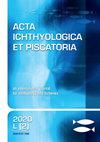Feeding habits of the spotted rose snapper, Lutjanus guttatus, (Actinopterygii, Perciformes, Lutjanidae), in the central Gulf of California, BCS, Mexico
IF 1
4区 农林科学
Q3 FISHERIES
引用次数: 7
Abstract
The spotted rose snapper, Lutjanus guttatus (Steindachner, 1869), is an important resource for the coastal fisheries of the Gulf of California, mainly due to its high commercial value. Despite this, there are no management measures for this species, owing in part to a lack of information on its basic biology and its trophic ecology in the area. In this context, the presently reported study had as objective to describe the feeding habits of L. guttatus through stomach content analyses, as well as to describe possible changes linked to sex, size, and season. Specimens were caught monthly from June 2016 to September 2017 with gillnets in Santa Rosalía, BCS, Mexico. The abundance, weight, and frequency of occurrence of each prey were assessed, and these parameters were integrated into the index of relative importance (%IRI) to determine the importance of each prey item in the L. guttatus diet. The Levin’s index was used to assess the trophic niche width of the species, the feeding strategy was evaluated using Costello’s graphic method and the trophic level was calculated. Finally, to establish whether there were significant differences in the diet by sex, size, or season a PERMANOVA test was used with a 95% confidence level. A total of 202 L. guttatus stomachs were analyzed, 191 of which contained food. A total of 26 prey items were identified. According to the %IRI, the most important prey were the teleost fishes Harengula thrissina (Jordan et Gilbert, 1882) (45.7%) and Sardinops sagax (Jenyns, 1842) (34.8%), the euphausiid Nyctiphanes simplex (13.4%), and the crustacean Penaeus spp. (5.6%). The PERMANOVA analysis resulted in significant differences between the analyzed categories; however, there were no significant differences in the interactions among the categories. According to Levin’s index, L. guttatus had a narrow trophic width, with changes in the main prey consumed by the different categories. According to our results, L. guttatus can be considered a benthopelagic opportunistic carnivorous predator with a narrow trophic niche, presenting mostly quantitative variations in its diet according to sex, size, and season. Its trophic plasticity allows it to take advantage of the most available and abundant food resources.墨西哥BCS加利福尼亚湾中部斑点玫瑰鲷的摄食习性(放线鱼科,鲈形目,斑点玫瑰鲷科)
斑点玫瑰鲷鱼,Lutjanus guttatus(Steindachner,1869),是加利福尼亚湾沿海渔业的重要资源,主要是由于其高商业价值。尽管如此,对该物种没有任何管理措施,部分原因是缺乏有关其基本生物学和该地区营养生态学的信息。在这种情况下,目前报道的研究目的是通过胃内容物分析来描述斑蝥的进食习惯,并描述与性别、大小和季节有关的可能变化。2016年6月至2017年9月,墨西哥BCS的Santa Rosalía每月用刺网捕获标本。评估了每种猎物的丰度、重量和出现频率,并将这些参数整合到相对重要性指数(%IRI)中,以确定每种猎物在乳杆菌饮食中的重要性。使用Levin指数评估该物种的营养生态位宽度,使用Costello图解法评估喂养策略,并计算营养水平。最后,为了确定性别、体型或季节的饮食是否存在显著差异,使用了95%置信水平的PERMANOVA测试。共分析了202个乳杆菌胃,其中191个胃含有食物。共发现26件猎物。根据%IRI,最重要的猎物是硬骨鱼Harengula trissina(Jordan et Gilbert,1882)(45.7%)和Sardinos sagax(Jenyns,1842;然而,不同类别之间的交互作用没有显著差异。根据Levin指数,L.guttatus的营养宽度很窄,不同种类的主要猎物会发生变化。根据我们的研究结果,L.guttatus可以被认为是一种营养生态位狭窄的底栖机会主义食肉动物,其饮食大多根据性别、体型和季节而存在数量变化。它的营养可塑性使它能够利用最可用和最丰富的食物资源。
本文章由计算机程序翻译,如有差异,请以英文原文为准。
求助全文
约1分钟内获得全文
求助全文
来源期刊

Acta Ichthyologica Et Piscatoria
FISHERIES-ZOOLOGY
CiteScore
2.20
自引率
0.00%
发文量
31
审稿时长
>12 weeks
期刊介绍:
ACTA ICHTHYOLOGICA ET PISCATORIA (AIeP) is an international, peer-reviewed scientific journal that publishes articles based on original experimental data or experimental methods, or new analyses of already existing data, in any aspect of ichthyology and fisheries (fin-fish only).
 求助内容:
求助内容: 应助结果提醒方式:
应助结果提醒方式:


